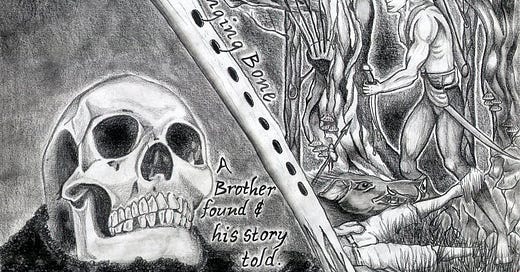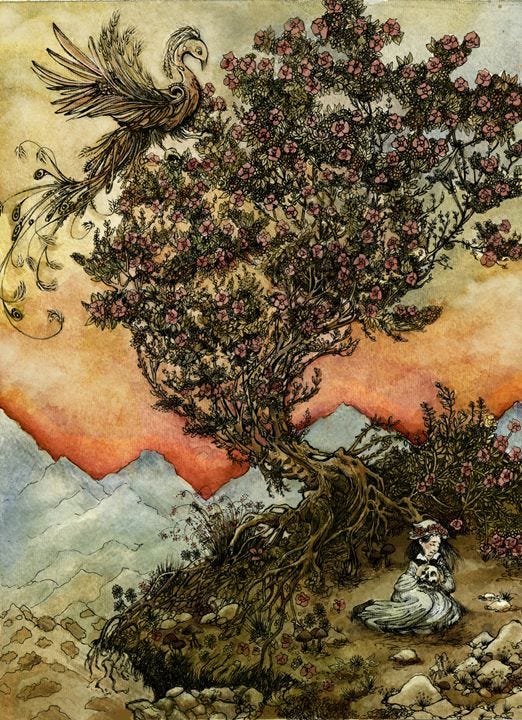The Spooky, Scary Skeletons of Justice
Whose bones are rattling around in the ground, crying out for truth?
Happy Halloween, dear readers!
Fairytales are chock-full of the dark, mysterious, and the spooky, but they always have a point in being that way. By opening our eyes to the shadows, they bring very important things to light.
Two of my favorite spooky fairytales are about the ways in which truth always comes back to haunt us — whether we have forgotten our deeds or not, the earth itself remembers, and it is alive with that memory. The heavens remember. Everything we do has ramifications. That’s why we can hold out hope for ultimate justice and truth, and also know, to ourselves, that nothing we do is truly “just about us.” It always involves the complex web of everything and anyone we interact with, too.
The Singing Bone
The first of these tales is “The Singing Bone,” recorded by the Grimms. As many fairytales do, this story starts with three brothers — two who are successful and cunning and one who is presumed to be an idiot. They are tasked with a contest to kill a wild boar and win the hand of a princess.
The first two are prideful, but the third brother accepts magical help and is able to kill the boar. In his eagerness to tell his brothers about his victory, the youngest brother incites their envy. So the two older brothers murder their little brother and bury him under a bridge. Then the eldest brother takes the boar, presents it to the king, and is given the princess to wed.
But truth and justice prevail — years pass, and a shepherd crossing the bridge notices a little white bone below in the sand. Since it is clean and white, he fashions the bone into a horn, but when he tries to blow through it, the bone begins to sing:
“Dear shepherd, blowing on my bone,
Hear my song, for I want you to know
My brothers killed me years ago!
They buried me by the brook that flows
And carried off the dead wild boar,
And won the king’s lone daughter.”
(Grimms Complete First Edition, Jack Zipes translation)
And so the dismal deed is revealed. The astonished shepherd brings the bone to the king, the skeleton of the dead youngest brother is exhumed, and the two wicked brothers are punished. If this story is feeling a lot like Cain and Abel to you, you would be right, for even in that tale, God says “Abel’s blood was crying to him from the ground.”
The Juniper Tree
(Illustration by Shelby E. Boswell)
A second Grimms’ tale is even grislier — “The Juniper Tree.” It tells of a young boy whose good-hearted, kind mother is buried beneath a beloved juniper tree, and, as in many fairy stories, his father goes on to marry a wicked woman. This wicked stepmother already has a daughter, Marlene, and she loathes the little boy for standing in Marlene’s way of inheriting everything. Marlene, incidentally, is not wicked in this story, unlike in Cinderella — she is a kind stepsister rather than an evil one. But we absolutely do have a malicious stepmother.
The stepmother one day murders the little boy, and, through an accident she stages with the corpse, convinces Marlene that she is the one who killed him. She exhorts Marlene to keep it all a secret. Then, (and here’s where things become really, really grotesque, so fair warning, please do not read this post to children, or while you are eating dinner) she cooks a stew out of the little boy’s corpse and feeds it to his father, never telling the man what’s in the stew, while Marlene weeps bitterly. Marlene is distraught and beside herself, and she mournfully buries the remaining bones beneath the juniper tree.
But as in “The Singing Bone,” justice will have the final word here, too. As Marlene buries the bones and weeps, the juniper tree bursts into flame, and from these flames rises a magnificent bird (a phoenix). And the bird, just like the bone from the previous story, sings the truth. It goes up to every rooftop in town and begins to sing,
“My Mother, she killed me.
My father, he ate me.
My sister, Marlene, she made sure to see
My bones were gathered secretly,
Bound nicely in silk, as neat as can be,
And laid beneath the juniper tree.
Tweet, tweet! What a lovely bird I am!”
(Grimms Complete First Edition, Jack Zipes translation)
And justice comes — both bright and shadowy — for the people who are affected differently by it. For Marlene, this is joyous news, and she weeps because her mourning has become sweet, as though this bird really were her brother.
But for the stepmother, this is catastrophic. Feel the dread in the way she reacts to the phoenix’s song:
“The mother stopped her ears, shut her eyes, and tried not to see or hear anything, but there was a roaring in her ears like a turbulent storm, and her eyes burned and flashed like lightning.”
“‘Oh, don’t go’ cried the wife. ‘I feel as if the whole house were shaking and about to go up in flames!’”
“‘Not me,’ said the wife, who jumped, and her hair flared up like red-hot flames. ‘I feel as if the world were coming to an end.’”
This is hellish language, but the hell is of her own making. As she goes out the door to face the music (literally), the bird drops a millstone on her head, and she is crushed to death. (And if you’re wondering why a millstone here, take a look at Mark 9:42 or Matthew 18:6, since these German fairy tales are coming from a Christian context.)
Spooky, scary truth
In each of these tales, the real spookiness is the truth — these people who committed crimes are now being haunted by the truth of what they have done. None of these secrets are allowed to remain buried.
And how afraid they are of the truth! It is punishment unto itself. Sometimes I think we look around at this Upside-Down world where ugly things happen, and people get away with it, and we wonder of the fairness of it all. But truth is truth, and ultimately all the masks will be off and the play will be over, and we’ll see everything for what it is, whether we like that or not. Such a prospect can either be hopeful and comforting for us, or it can be spooky and terrifying, depending on where we choose to stand in relation to the truth. That’s the Right-Side-Up reality that fairytales help us to see.
Enjoyed this article? Consider subscribing or leaving a tip. It’s never expected, always appreciated, and helps me keep writing. Thank you!






Very interesting. Thank you